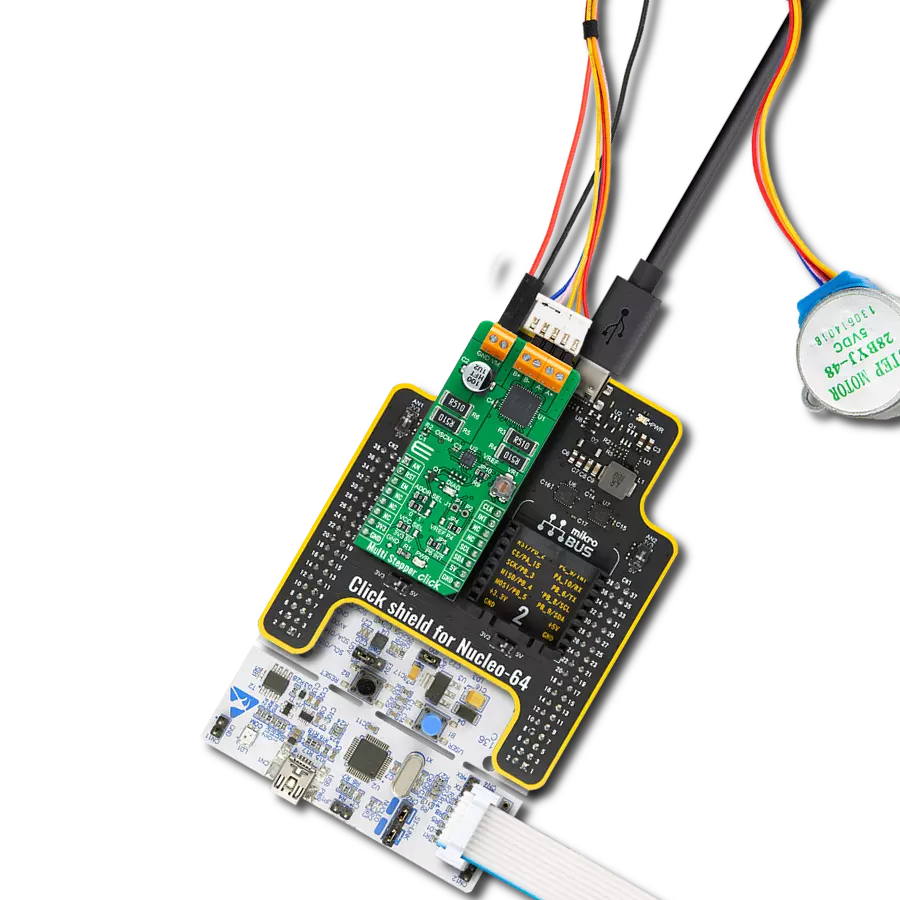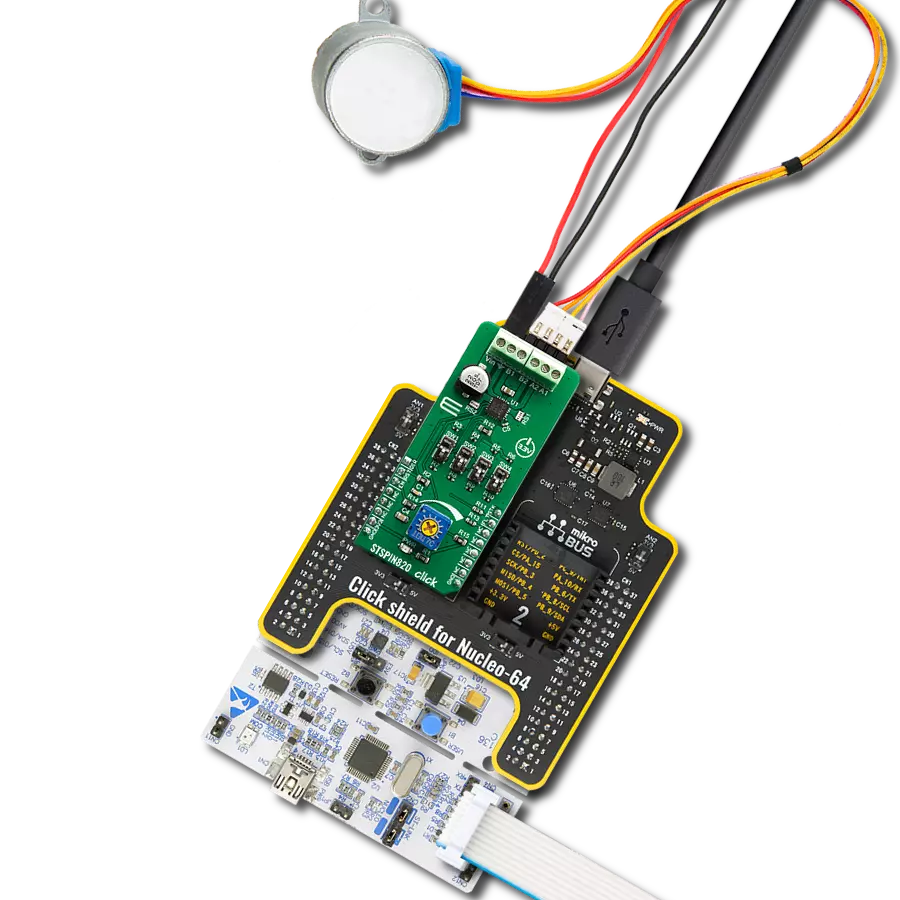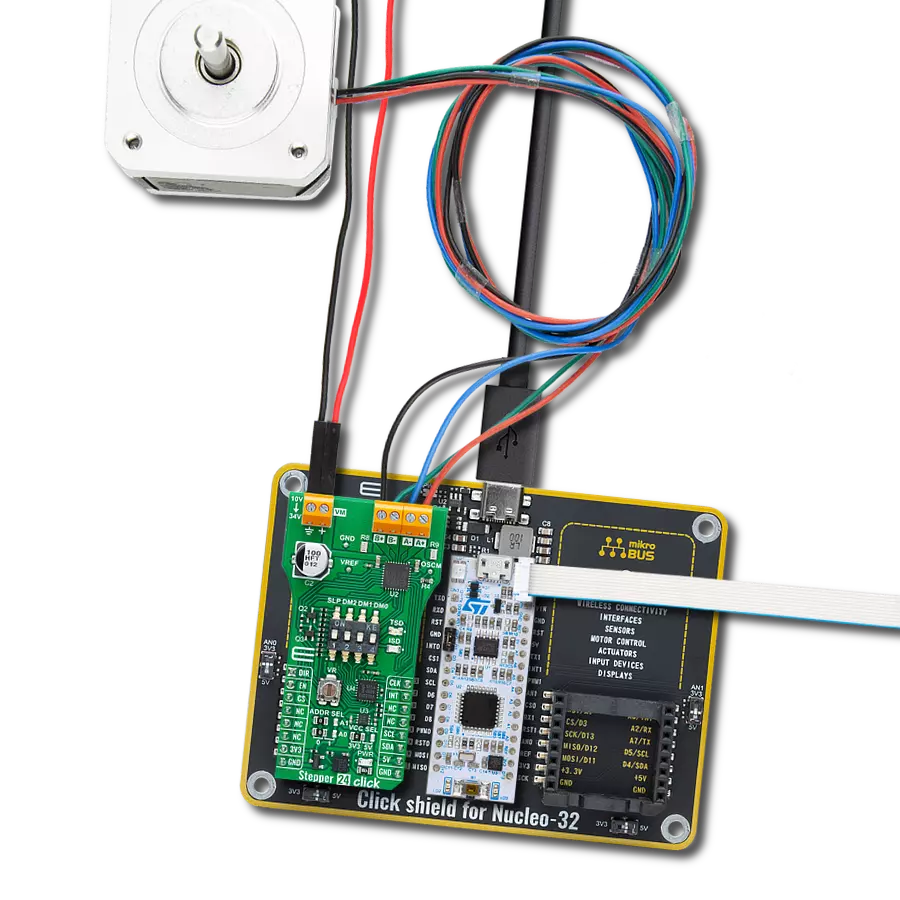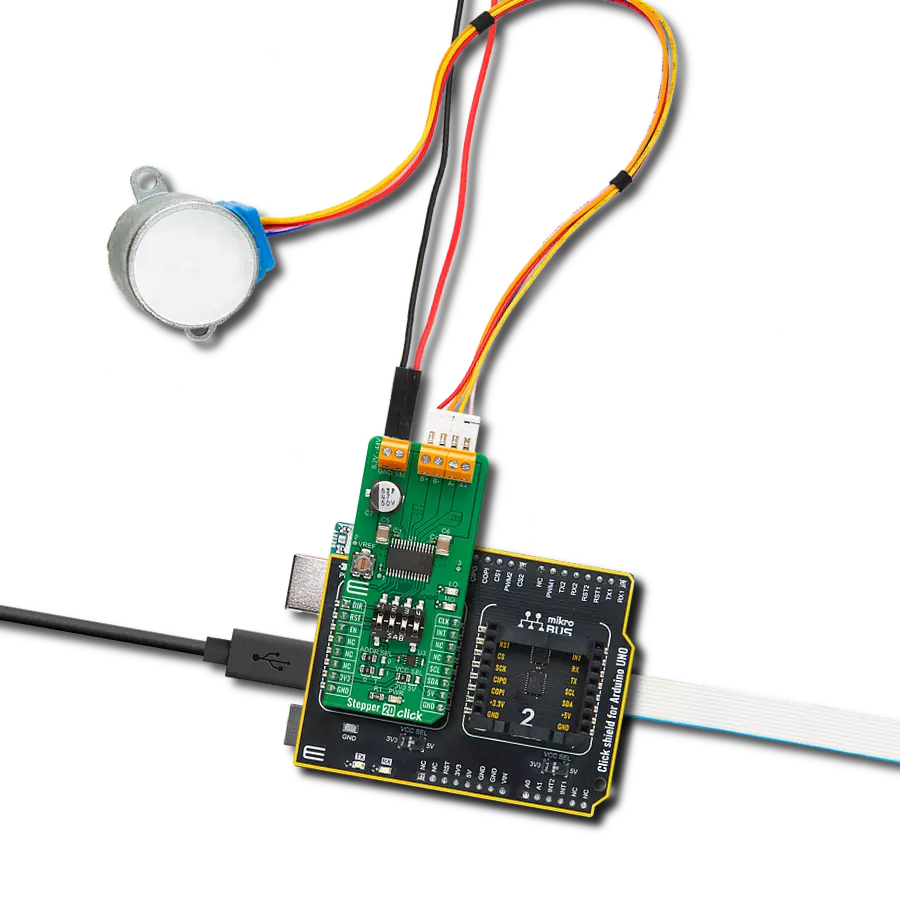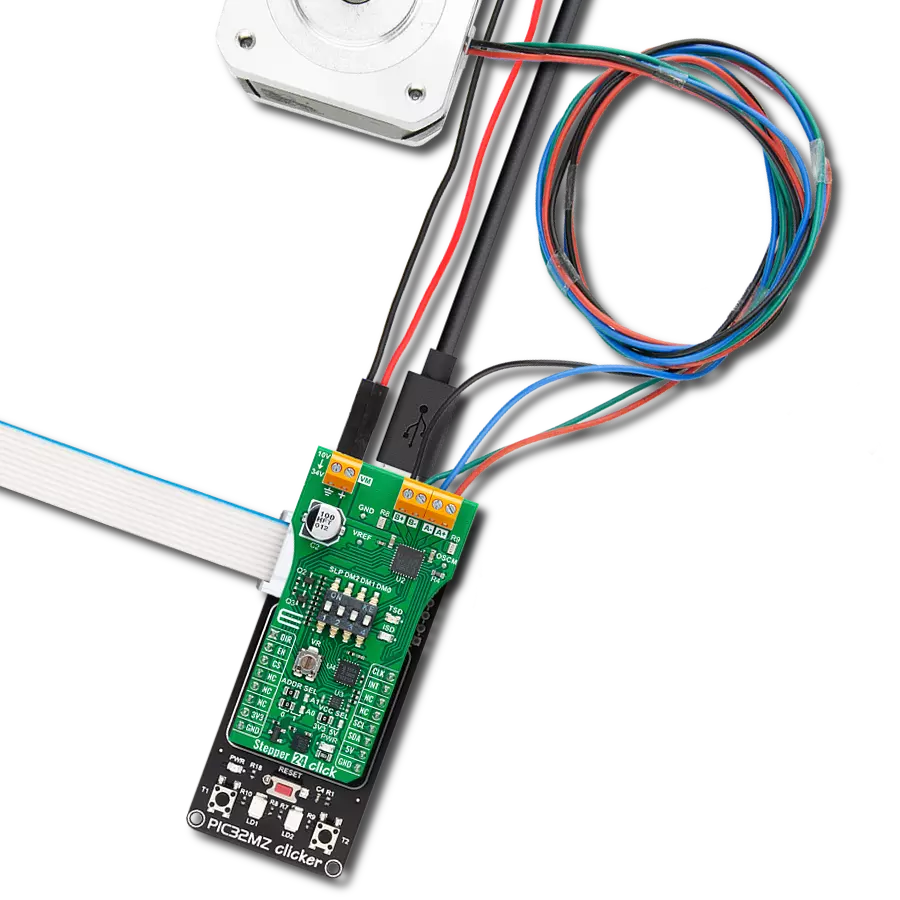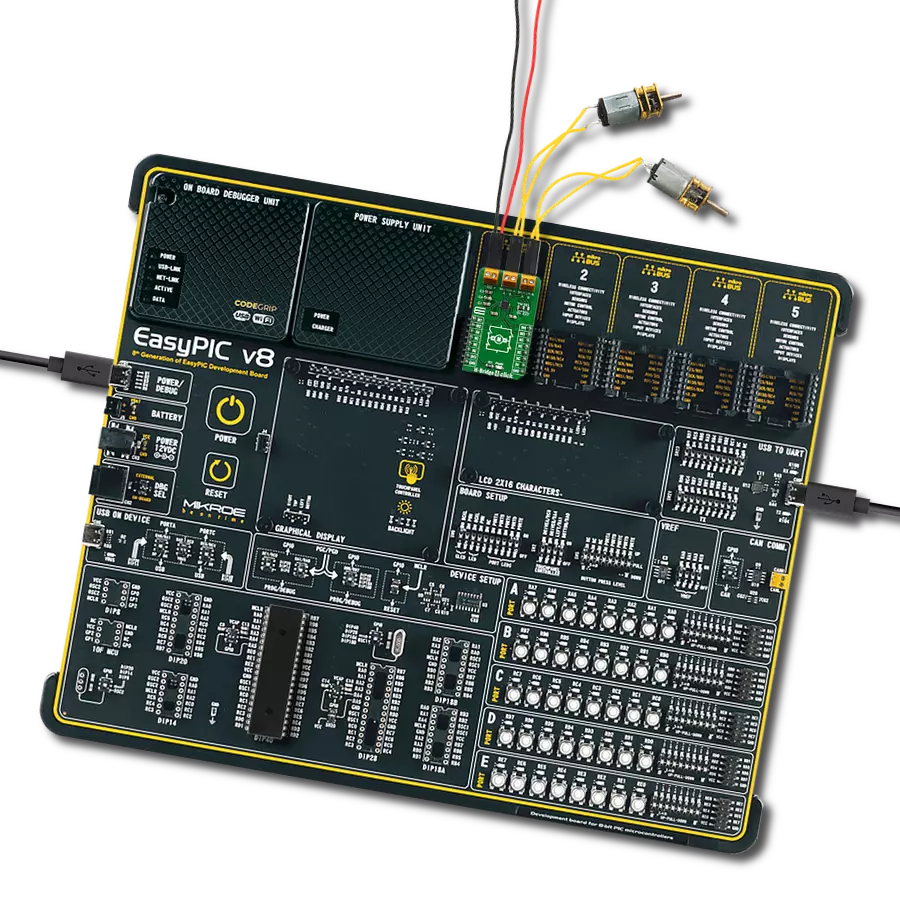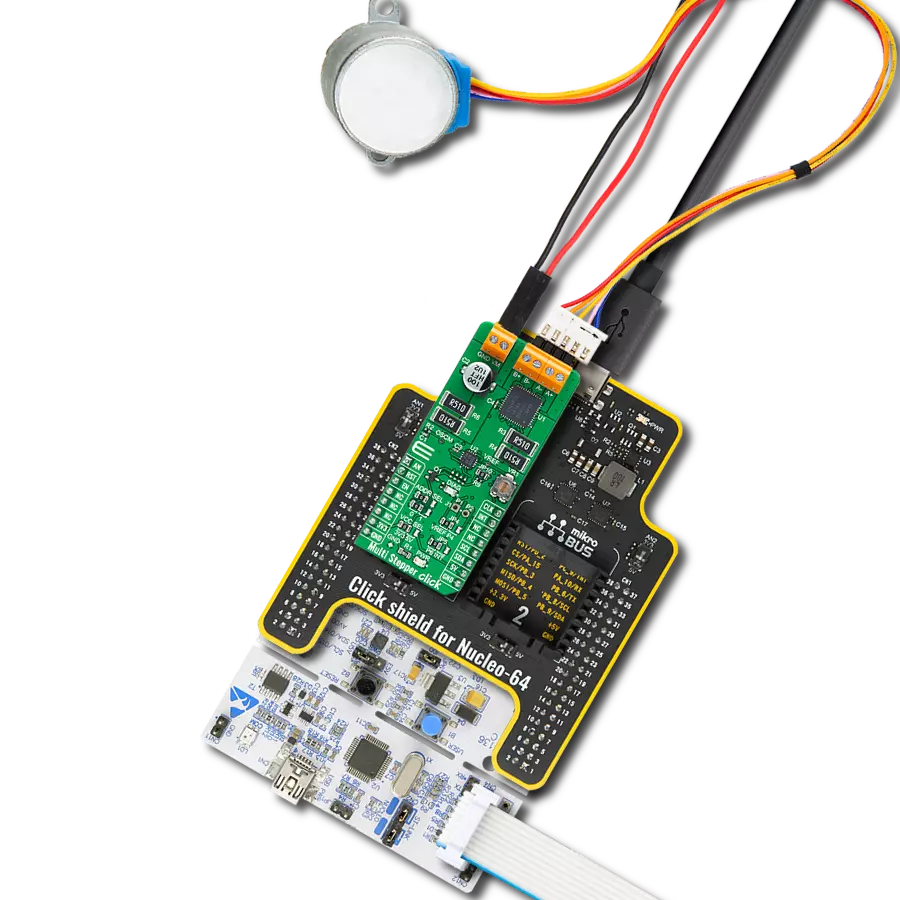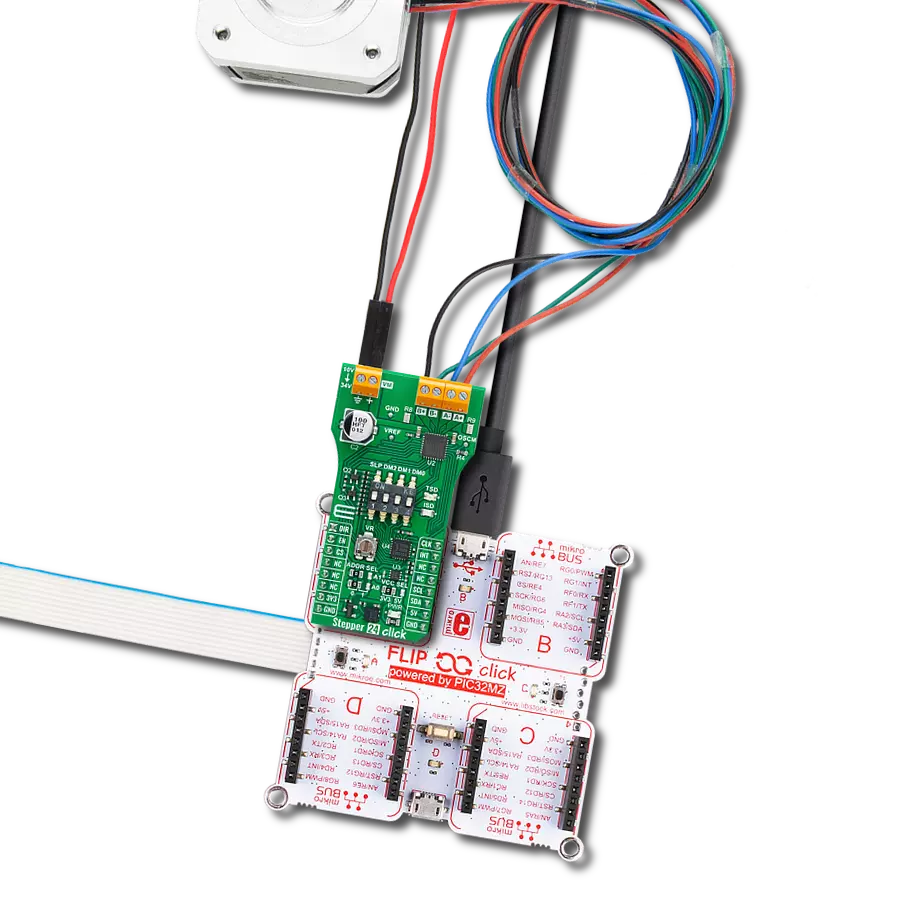Our integrated motor-driver solution for bipolar stepper motors offers the perfect blend of precision and efficiency, ensuring your projects perform flawlessly
A
A
Hardware Overview
How does it work?
Stepper 15 Click is based on the DRV8889A, an integrated motor-driver solution for bipolar stepper motors from Texas Instruments. The DRV8889A integrates two N-channel power MOSFET H-bridges (disabled by default after Power-Up), integrated current sense and regulation circuitry, and a microstepping indexer. It can be powered with a supply voltage from 4.5 to 45V, providing an output current of up to 2.4A peak, 1.5A full-scale, or 1.1A RMS. The DRV8889A uses an integrated current-sense architecture, eliminating the need for two external power-sense resistors. This architecture removes the power dissipated in the sense of resistors using a current mirror approach and the internal power MOSFETs for current sensing. It also includes an integrated torque DAC that allows the controller to scale the output current through a full-duplex, 4-wire
synchronous SPI interface without needing to scale the voltage reference. The torque DAC allows the controller to save system power by decreasing the motor current consumption when high output torque is not required. A simple STEP/DIR interface allows an external MCU to manage the direction and step rate of the stepper motor. The internal indexer can execute high-accuracy microstepping without requiring the MCU to handle the winding current level. The indexer is capable of the whole step, half step, and 1/4, 1/8, 1/16, 1/32, 1/64, 1/128, and 1/256 microstepping. Also, a noncircular half-stepping mode is available for increased torque output at higher motor RPM and a standard half-stepping mode. Unlike the STEP pin controlled by the PWM pin from the mikroBUS™ socket, other pins from the DRV8889A, such as Sleep mode selection, fault indicator, direction selection, and
device turn-off pins are controlled through a well-known 8bit I/O expander, the PCA9538 from NXP Semiconductor using the standard I2C 2-Wire interface with a maximum frequency of 400kHz. The PCA9538 also uses RST and INT pins from the mikroBUS™ socket as a hardware reset and interrupt function. This Click board™ can operate with both 3.3V and 5V logic voltage levels selected via the VCC SEL jumper. It allows both 3.3V and 5V capable MCUs to use the communication lines properly. Additionally, there is a possibility for stepper motor driver power supply selection via jumper labeled as VM SEL to supply the DRV8889A from an external input terminal in the range from 4.5 to 45V or with a 5V from mikroBUS™ power rail.
Features overview
Development board
Arduino UNO is a versatile microcontroller board built around the ATmega328P chip. It offers extensive connectivity options for various projects, featuring 14 digital input/output pins, six of which are PWM-capable, along with six analog inputs. Its core components include a 16MHz ceramic resonator, a USB connection, a power jack, an
ICSP header, and a reset button, providing everything necessary to power and program the board. The Uno is ready to go, whether connected to a computer via USB or powered by an AC-to-DC adapter or battery. As the first USB Arduino board, it serves as the benchmark for the Arduino platform, with "Uno" symbolizing its status as the
first in a series. This name choice, meaning "one" in Italian, commemorates the launch of Arduino Software (IDE) 1.0. Initially introduced alongside version 1.0 of the Arduino Software (IDE), the Uno has since become the foundational model for subsequent Arduino releases, embodying the platform's evolution.
Microcontroller Overview
MCU Card / MCU

Architecture
AVR
MCU Memory (KB)
32
Silicon Vendor
Microchip
Pin count
28
RAM (Bytes)
2048
You complete me!
Accessories
Click Shield for Arduino UNO has two proprietary mikroBUS™ sockets, allowing all the Click board™ devices to be interfaced with the Arduino UNO board without effort. The Arduino Uno, a microcontroller board based on the ATmega328P, provides an affordable and flexible way for users to try out new concepts and build prototypes with the ATmega328P microcontroller from various combinations of performance, power consumption, and features. The Arduino Uno has 14 digital input/output pins (of which six can be used as PWM outputs), six analog inputs, a 16 MHz ceramic resonator (CSTCE16M0V53-R0), a USB connection, a power jack, an ICSP header, and reset button. Most of the ATmega328P microcontroller pins are brought to the IO pins on the left and right edge of the board, which are then connected to two existing mikroBUS™ sockets. This Click Shield also has several switches that perform functions such as selecting the logic levels of analog signals on mikroBUS™ sockets and selecting logic voltage levels of the mikroBUS™ sockets themselves. Besides, the user is offered the possibility of using any Click board™ with the help of existing bidirectional level-shifting voltage translators, regardless of whether the Click board™ operates at a 3.3V or 5V logic voltage level. Once you connect the Arduino UNO board with our Click Shield for Arduino UNO, you can access hundreds of Click boards™, working with 3.3V or 5V logic voltage levels.
The 28BYJ-48 is an adaptable 5VDC stepper motor with a compact design, ideal for various applications. It features four phases, a speed variation ratio of 1/64, and a stride angle of 5.625°/64 steps, allowing precise control. The motor operates at a frequency of 100Hz and has a DC resistance of 50Ω ±7% at 25°C. It boasts an idle in-traction frequency greater than 600Hz and an idle out-traction frequency exceeding 1000Hz, ensuring reliability in different scenarios. With a self-positioning torque and in-traction torque both exceeding 34.3mN.m at 120Hz, the 28BYJ-48 offers robust performance. Its friction torque ranges from 600 to 1200 gf.cm, while the pull-in torque is 300 gf.cm. This motor makes a reliable and efficient choice for your stepper motor needs.
Used MCU Pins
mikroBUS™ mapper
Take a closer look
Click board™ Schematic

Step by step
Project assembly
Track your results in real time
Application Output
1. Application Output - In Debug mode, the 'Application Output' window enables real-time data monitoring, offering direct insight into execution results. Ensure proper data display by configuring the environment correctly using the provided tutorial.

2. UART Terminal - Use the UART Terminal to monitor data transmission via a USB to UART converter, allowing direct communication between the Click board™ and your development system. Configure the baud rate and other serial settings according to your project's requirements to ensure proper functionality. For step-by-step setup instructions, refer to the provided tutorial.

3. Plot Output - The Plot feature offers a powerful way to visualize real-time sensor data, enabling trend analysis, debugging, and comparison of multiple data points. To set it up correctly, follow the provided tutorial, which includes a step-by-step example of using the Plot feature to display Click board™ readings. To use the Plot feature in your code, use the function: plot(*insert_graph_name*, variable_name);. This is a general format, and it is up to the user to replace 'insert_graph_name' with the actual graph name and 'variable_name' with the parameter to be displayed.

Software Support
Library Description
This library contains API for Stepper 15 Click driver.
Key functions:
stepper15_make_one_step- Stepper 15 make one step function.stepper15_set_direction- Stepper 15 set direction function.stepper15_step_by_angle- Stepper 15 step by angle function.
Open Source
Code example
The complete application code and a ready-to-use project are available through the NECTO Studio Package Manager for direct installation in the NECTO Studio. The application code can also be found on the MIKROE GitHub account.
/*!
* @file main.c
* @brief Stepper15 Click example
*
* # Description
* This library contains API for the Stepper 15 Click driver.
* The library contains drivers for work control of the Stepper Motor.
*
* The demo application is composed of two sections :
*
* ## Application Init
* Initializes I2C and SPI driver and set default configuration,
* enable the device and enable outputs mode.
*
* ## Application Task
* The application task represents an example that demonstrates
* the use of the Stepper 15 Click board™
* with which the user can sequentially move the motor.
* The first part of the sequence executes the clockwise/counterclockwise motor movement
* for an angle of 90-degrees with a step speed of 85/100%,
* all the way to the last sequence of the same movement routine of 360-degree angle
* with a step speed of 85/100%.
* Results are sent to the USART Terminal, where you can track their changes.
*
* @author Nenad Filipovic
*
*/
#include "board.h"
#include "log.h"
#include "stepper15.h"
static stepper15_t stepper15;
static log_t logger;
static uint8_t step_speed = 100;
static uint16_t step_360 = 200;
void application_init ( void ) {
log_cfg_t log_cfg; /**< Logger config object. */
stepper15_cfg_t stepper15_cfg; /**< Click config object. */
/**
* Logger initialization.
* Default baud rate: 115200
* Default log level: LOG_LEVEL_DEBUG
* @note If USB_UART_RX and USB_UART_TX
* are defined as HAL_PIN_NC, you will
* need to define them manually for log to work.
* See @b LOG_MAP_USB_UART macro definition for detailed explanation.
*/
LOG_MAP_USB_UART( log_cfg );
log_init( &logger, &log_cfg );
log_info( &logger, " Application Init " );
// Click initialization.
stepper15_cfg_setup( &stepper15_cfg );
STEPPER15_MAP_MIKROBUS( stepper15_cfg, MIKROBUS_1 );
err_t init_flag = stepper15_init( &stepper15, &stepper15_cfg );
if ( ( init_flag == I2C_MASTER_ERROR ) || ( init_flag == SPI_MASTER_ERROR ) ) {
log_error( &logger, " Application Init Error. " );
log_info( &logger, " Please, run program again... " );
for ( ; ; );
}
stepper15_default_cfg ( &stepper15 );
log_info( &logger, " Application Task " );
log_printf( &logger, "---------------------------------\r\n" );
stepper15_set_work_mode( &stepper15, STEPPER15_WORK_MODE_ENABLE_DEVICE );
Delay_ms ( 100 );
stepper15_set_output_mode( &stepper15, STEPPER15_OUTPUT_MODE_OUTPUTS_ENABLE );
Delay_ms ( 100 );
if ( stepper15_get_fault_condition( &stepper15 ) == STEPPER15_FAULT_CONDITION ) {
log_printf( &logger, " Fault condition \r\n" );
} else {
log_printf( &logger, " Correct condition \r\n" );
}
log_printf( &logger, "---------------------------------\r\n" );
log_printf( &logger, " Stop the stepper motor \r\n" );
stepper15_motor_stop( &stepper15 );
Delay_ms ( 1000 );
}
void application_task ( void ) {
log_printf( &logger, "---------------------------------\r\n" );
log_printf( &logger, " Clockwise motion \r\n" );
log_printf( &logger, " Angle of rotation : 90 degrees \r\n" );
log_printf( &logger, " Step speed : 85 %% \r\n" );
stepper15_set_direction ( &stepper15, STEPPER15_DIRECTION_CLOCKWISE );
stepper15_step_by_angle( &stepper15, step_speed - 15, 90, step_360 );
Delay_ms ( 1000 );
Delay_ms ( 1000 );
log_printf( &logger, "---------------------------------\r\n" );
log_printf( &logger, " Counterclockwise motion \r\n" );
log_printf( &logger, " Angle of rotation : 180 degrees \r\n" );
log_printf( &logger, " Step speed : 85 %% \r\n" );
stepper15_set_direction ( &stepper15, STEPPER15_DIRECTION_COUNTERCLOCKWISE );
stepper15_step_by_angle( &stepper15, step_speed - 15, 180, step_360 );
Delay_ms ( 1000 );
Delay_ms ( 1000 );
log_printf( &logger, "---------------------------------\r\n" );
log_printf( &logger, " Clockwise motion \r\n" );
log_printf( &logger, " Angle of rotation : 270 degrees \r\n" );
log_printf( &logger, " Step speed : 90 %% \r\n" );
stepper15_set_direction ( &stepper15, STEPPER15_DIRECTION_CLOCKWISE );
stepper15_step_by_angle( &stepper15, step_speed - 10, 270, step_360 );
Delay_ms ( 1000 );
Delay_ms ( 1000 );
log_printf( &logger, "---------------------------------\r\n" );
log_printf( &logger, " Counterclockwise motion \r\n" );
log_printf( &logger, " Angle of rotation : 360 degrees \r\n" );
log_printf( &logger, " Step speed : 100 %% \r\n" );
stepper15_set_direction ( &stepper15, STEPPER15_DIRECTION_COUNTERCLOCKWISE );
stepper15_step_by_angle( &stepper15, step_speed, 360, step_360 );
Delay_ms ( 1000 );
Delay_ms ( 1000 );
log_printf( &logger, "---------------------------------\r\n" );
log_printf( &logger, " Clockwise motion \r\n" );
log_printf( &logger, " Angle of rotation : 360 degrees \r\n" );
log_printf( &logger, " Step speed : 100 %% \r\n" );
stepper15_set_direction ( &stepper15, STEPPER15_DIRECTION_CLOCKWISE );
stepper15_step_by_angle( &stepper15, step_speed, 360, step_360 );
Delay_ms ( 1000 );
Delay_ms ( 1000 );
}
int main ( void )
{
/* Do not remove this line or clock might not be set correctly. */
#ifdef PREINIT_SUPPORTED
preinit();
#endif
application_init( );
for ( ; ; )
{
application_task( );
}
return 0;
}
// ------------------------------------------------------------------------ END
Additional Support
Resources
Category:Stepper






















